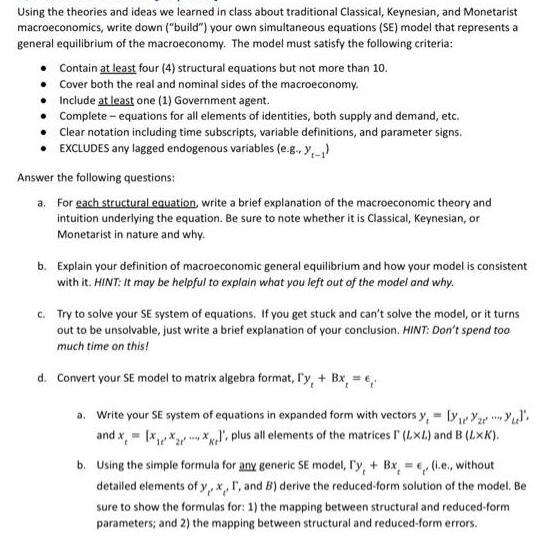Answered step by step
Verified Expert Solution
Question
1 Approved Answer
Using the theories and ideas we learned in class about traditional Classical, Keynesian, and Monetarist macroeconomics, write down (build) your own simultaneous equations (SE)

Using the theories and ideas we learned in class about traditional Classical, Keynesian, and Monetarist macroeconomics, write down ("build") your own simultaneous equations (SE) model that represents a general equilibrium of the macroeconomy. The model must satisfy the following criteria: Contain at least four (4) structural equations but not more than 10. Cover both the real and nominal sides of the macroeconomy. Include at least one (1) Government agent. Complete - equations for all elements of identities, both supply and demand, etc. Clear notation including time subscripts, variable definitions, and parameter signs. EXCLUDES any lagged endogenous variables (e.g., -1) Answer the following questions: a. For each structural equation, write a brief explanation of the macroeconomic theory and intuition underlying the equation. Be sure to note whether it is Classical, Keynesian, or Monetarist in nature and why. b. Explain your definition of macroeconomic general equilibrium and how your model is consistent with it. HINT: It may be helpful to explain what you left out of the model and why. c. Try to solve your SE system of equations. If you get stuck and can't solve the model, or it turns out to be unsolvable, just write a brief explanation of your conclusion. HINT: Don't spend too much time on this! d. Convert your SE model to matrix algebra format, I'y, + Bx, = 6, a. Write your SE system of equations in expanded form with vectors y, yul. and xxxxl. plus all elements of the matrices I (LXL) and B (LxK). b. Using the simple formula for any generic SE model, r'y, + Bx, = e(i.e., without detailed elements of y, x, I, and B) derive the reduced-form solution of the model. Be sure to show the formulas for: 1) the mapping between structural and reduced-form parameters; and 2) the mapping between structural and reduced-form errors.
Step by Step Solution
★★★★★
3.45 Rating (155 Votes )
There are 3 Steps involved in it
Step: 1
Example Simultaneous Equations Model Aggregate demand equation ADt CYt1 Ir Gt NXt Pt Aggregate supply equation Yt YNt zt Investment equation It I0 di r Price equation Pt PYt1 Pt1 a Explanation of the ...
Get Instant Access to Expert-Tailored Solutions
See step-by-step solutions with expert insights and AI powered tools for academic success
Step: 2

Step: 3

Ace Your Homework with AI
Get the answers you need in no time with our AI-driven, step-by-step assistance
Get Started


